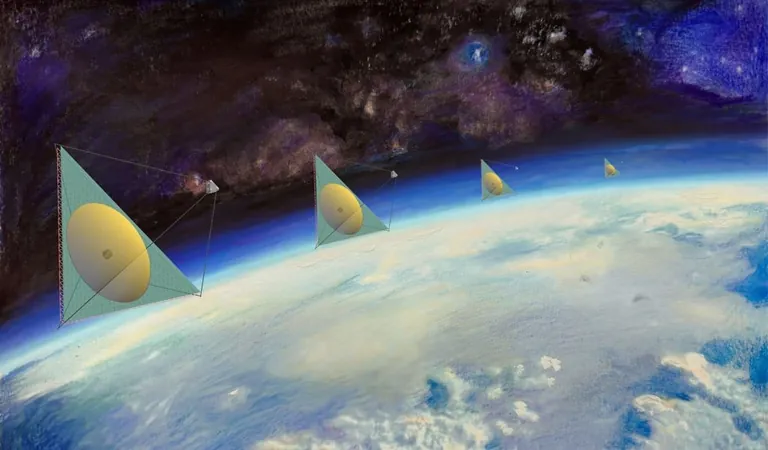
Revolutionary Space Telescopes: Could Future Designs Use Thin Membranes to Unlock the Cosmos?
2024-11-03
Author: William
Introduction
Space-based telescopes are game-changers in our quest to understand the universe. Unlike ground-based telescopes, their views aren’t hindered by atmospheric disturbances, granting us crystal-clear images of distant galaxies and celestial phenomena. However, the size of telescopes remains a vexing challenge. Take the remarkable James Webb Space Telescope; its primary mirror spans a mere 6.5 meters. In contrast, the Extremely Large Telescope currently being constructed in northern Chile boasts a staggering 39-meter mirror. Imagine the astronomical advances possible if we could launch comparable sizes into the depths of space! A recent study explores this tantalizing prospect.
The Concept
The crux of the study reveals a groundbreaking idea: telescope mirrors don’t necessarily need to be constructed from bulky materials. Instead, an effective reflective surface could be created using a thin sheet of specialized material. Think about it—a lightweight reflective membrane could be rolled, making it easy to transport in a launch vehicle. For example, launching a 40-meter roll of aluminum foil could potentially revolutionize how we capture images of the cosmos.
Engineering Challenges
However, the engineering complexities are non-trivial. Once in space, the rolled membrane must be carefully unfurled into its intended shape. A detector must be established for image focusing, maintaining precise alignment with the vast mirror surface. While theoretical solutions involve slender support structures, the challenge doesn't end here. Even in the weightlessness of space, such a delicate mirror could deform over time, risking the quality of the astronomical images it could capture. Addressing this deformation dilemma is a central goal of the researchers' study.
Maintaining Precision
The good news is that once deployed, the membrane mirror can retain its shape with minimal distortion. Yet, to achieve razor-sharp images, the mirror needs to maintain an extremely precise focus, akin to the resolution demanded by the Hubble Space Telescope, which faced significant operational challenges due to a mere hair-thin error in its mirror shape. This undeniable precision is paramount; any significant deviation could render the membrane telescope ineffective.
Adaptive Optics and Innovations
To tackle these challenges, the authors turn to a proven solution in astronomy: adaptive optics. Commonly used in ground telescopes to combat atmospheric turbulence, adaptive optics employs actuators that adjust the mirror's shape in real-time. But, transferring this technology to a membrane structure would require complex systems that may outweigh the benefits. Instead, the study proposes an innovative alternative—laser projection.
Laser Projections
Using laser projections, astronomers could manipulate the mirror’s shape through radiative recoil, which relies on the dynamic properties of the thin membrane. The authors have conducted laboratory experiments demonstrating the feasibility of "radiative adaptive optics," suggesting that this method could fine-tune the mirror's focus as needed, in real time.
Future Prospects
While translating these findings from the lab to the vacuum of space introduces further challenges, the potential benefits are immense. There’s hope that in the coming years, we could construct entire arrays of these advanced membrane telescopes. Such an evolution in telescope technology may unlock newfound details about distant galaxies and cosmic phenomena, offering insights we can scarcely imagine today.
Conclusion
Could the future of astronomy really hinge on thin membranes unfurled among the stars? Only time will tell, but the possibilities keep our gaze firmly fixed on the cosmos!









 Brasil (PT)
Brasil (PT)
 Canada (EN)
Canada (EN)
 Chile (ES)
Chile (ES)
 Česko (CS)
Česko (CS)
 대한민국 (KO)
대한민국 (KO)
 España (ES)
España (ES)
 France (FR)
France (FR)
 Hong Kong (EN)
Hong Kong (EN)
 Italia (IT)
Italia (IT)
 日本 (JA)
日本 (JA)
 Magyarország (HU)
Magyarország (HU)
 Norge (NO)
Norge (NO)
 Polska (PL)
Polska (PL)
 Schweiz (DE)
Schweiz (DE)
 Singapore (EN)
Singapore (EN)
 Sverige (SV)
Sverige (SV)
 Suomi (FI)
Suomi (FI)
 Türkiye (TR)
Türkiye (TR)
 الإمارات العربية المتحدة (AR)
الإمارات العربية المتحدة (AR)